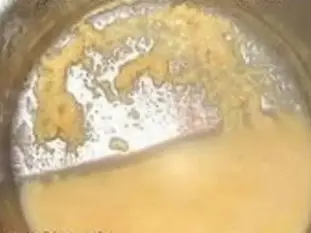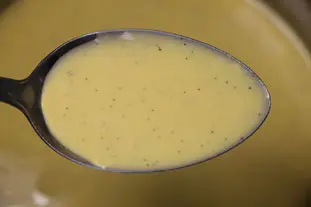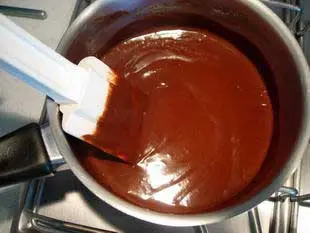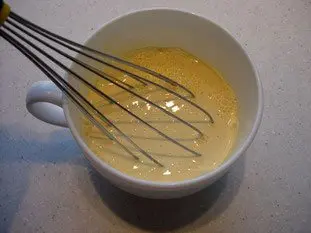This site uses only a few technical cookies necessary for its operation. By continuing to browse, you accept their use.
To find out more...
To find out more...
Tranché, dissociated, failed, in short... missed!

When preparing a sauce or a cream, there's always a (small) risk that the creamy preparation you're working on will suddenly separate into two parts of different textures: a liquid part, for example, and a more or less solid part, or even become lumpy.
It's terribly frustrating, but we'll see that it's not always irremediable, and that you can try to make up for it with a few simple gestures.
It's terribly frustrating, but we'll see that it's not always irremediable, and that you can try to make up for it with a few simple gestures.
13 K 5/5 (2 reviews)
Keywords for this post:SauceCreamTranchéMissedCatching upTipTrickRecoveryLast modified on: June 19th 2023
Tranché, dissociated, failed, in short... missed!
I've already talked to you about the rather special case of warm emulsified sauces (béarnaise, hollandaise) and how to make up for them in the event of tragedy, so I won't go into that again, but this time we'll concentrate a little on creams.
That's just what "tranchée" means: the taste is unaffected, but the texture is completely, and we amateurs simply say "missed", "failed", "screwed up" or many other terms...
Too much can be an ingredient, a duration, a temperature.
Too much of what? Well, that's where it becomes very much a question of the preparation you were doing, so let's look at a few emblematic cases.
To make up for this, try giving it a good whirl with the mixer.
To make up for this, try putting it in the microwave for a few seconds, before whisking or even mixing vigorously, to bring the mixture back to an even temperature.
Note that in this case, cream that curdles is unfortunately irrecoverable: your cream has turned into cheese.
To sum up: although cream curdling can be very stressful during preparation, it's not always irreversible, and can often be remedied by a simple gesture.
Tranchée?
When a cream "tranche", a french chef word, it's simply no longer homogeneous: instead of a single part, there are several parts in the bowl or saucepan, of different textures, liquid and solid in general.That's just what "tranchée" means: the taste is unaffected, but the texture is completely, and we amateurs simply say "missed", "failed", "screwed up" or many other terms...
What's happened?
It's difficult to make a general rule but it can be summed up as "There was too much..." or sometimes "There wasn't enough...".Too much can be an ingredient, a duration, a temperature.
Too much of what? Well, that's where it becomes very much a question of the preparation you were doing, so let's look at a few emblematic cases.
The custard
the custard you started with suddenly turns into a big lumpy mess, you've probably overcooked it by more than 185°F (85°C), or cooked it too quickly (over a hot fire).To make up for this, try giving it a good whirl with the mixer.

A ganache
A ganache that tranche is very often a temperature problem: the chocolate begins to set on its own, resulting in lumps, because the temperature of the mixture is heterogeneous.To make up for this, try putting it in the microwave for a few seconds, before whisking or even mixing vigorously, to bring the mixture back to an even temperature.

A mixture of cream + an acidic ingredient
If you add lemon juice directly to crème fraiche (for example), there's a great risk that it will curdle, which is normal, and therefore slice. To avoid this, you can 1) use liquid cream, for which there is less risk 2) add a pinch of bicarbonate of soda to the lemon juice, which will foam up a little but is harmless.Note that in this case, cream that curdles is unfortunately irrecoverable: your cream has turned into cheese.

To sum up: although cream curdling can be very stressful during preparation, it's not always irreversible, and can often be remedied by a simple gesture.
Lasts posts
Butter vs. grease
We often read in a recipe where a pastry is put into a mould that, just before pouring, the mould should be buttered or greased. But what's the difference between these 2 terms?December 1st 20251,0555
Getting out of the fridge early
Very often when you're cooking, you need to take food or preparations out of the fridge, to use them in the recipe in progress. There's nothing tricky about this: you just take them out of the fridge and use them, usually immediately, in the recipe. But is this really a good method?November 24th 20251,1535
Who's making the croissants?
When you look at a bakery from the outside, you naturally think that in the bakery, the bakers make the bread, and in the laboratory, the pastry chefs make the cakes. It's very often like that, with each of these professions having quite different ways of working, but sometimes there's also one...November 23th 20251,048
Oven height
When we put a dish or cake in the oven, we naturally tend to put it on the middle shelf, and that's what we usually do. But in some cases, this position and height can be a little tricky, so let's find out why.October 8th 20252,8315
The importance of sieving
In recipes that use a fine powder (flour, powdered sugar, etc.), you'll often see the advice to sift before using it. To sift is to pass the powder in question through a sieve (a very fine strainer) before incorporating it into your recipe. It's often advice, but is it really useful?September 3rd 20257,5793
Other pages you may also like
Drawing a pattern in pastry
Often in the kitchen, in pastry-making, or in baking, we need to trace a pattern on a pastry. It's just a question of aesthetics but it has its effect after baking on a galette, pithiviers, pâté en croute (terrine in a pie crust), etc.May 23th 201935 K4.1
No need to boil gelatin
Gelatin is a magical ingredient for making light, creamy, structured desserts, yet it's often misused in the kitchen. A common mistake in some recipes is the idea that it needs to be boiled for it to work properly, but this is a mistake indeed: gelatin melts at a much lower temperature, around...November 21th 20248,3115
Remove bones from fish
Let's talk about fish: It's not a scoop, it's much more pleasant to eat fish from which all the bones have been carefully removed, even if it's a rather painful and time-consuming job, the result is worthy of your efforts. Here are some important points to keep in mind.October 16th 202114 K5
A few tips for effective kneading at home
When you have to knead dough for bread or some other recipe, you may well use a food processor or the type of machine known as a stand mixer. The best-known brands are Kenwood and KitchenAid. They are useful tools, but here are a few tips to help you get the best out of them.June 23th 2021284 K 23.8
The so-called "nervous" meats
You've probably heard this before, we're talking about "nervous" meat, or meat with nerves, to describe what is indicated by the blue arrow on the left. This is a piece of beef, and what we call a nerve is not a nerve, it is in fact collagen (chemists sometimes call it a "collagen sink"), a...April 16th 202137 K4.5
Post a comment or question
Follow this page
If you are interested in this page, you can "follow" it, by entering your email address here. You will then receive a notification immediately each time the page is modified or a new comment is added. Please note that you will need to confirm this following.
Note: We'll never share your e-mail address with anyone else.
Alternatively: you can subscribe to the mailing list of cooling-ez.com , you will receive a e-mail for each new recipe published on the site.









